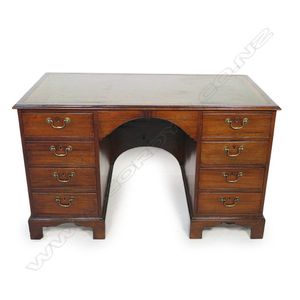George III Mahogany Kneehole Desk with Green Leather Inset
George III mahogany kneehole desk, green tooled leather inset top above the four drawer twin pedestals with brass swan neck handles, raised on bracket feet. 128 cm x 67 cm x 72 cm.
You must be a subscriber, and be logged in to view price and dealer details.
Subscribe Now to view actual auction price for this item
When you subscribe, you have the option of setting the currency in which to display prices to $Au, $US, $NZ or Stg.
This item has been sold, and the description, image and price are for reference purposes only.
- Bracket Feet - On bracket feet the corner edge is square and joined by a mitre to its partner on the opposite angle. The inner edge is usually shaped or scalloped. Bracket feet were first introduced in the early 18th century and used until c. 1830 and are found on carcase furniture such as chests, cabinets, bookcases and bureaux.
Ogee bracket feet, a variation on straight bracket feet, have the outside edge forming an "S" shaped curve with the top bulging outward and the bottom turning inward.
On splayed bracket feet, the exterior edge curves outward. - George Iii - George III (1738 - 1820) was King of Great Britain and Ireland from 1760 to 1820.
- Blind Tooling / Blind Tooled - Blind tooling is a technique used in the decoration of leather goods such as book covers, belts, and wallets. It involves the use of specialized tools to impress designs and patterns onto the surface of the leather without the use of added colour.
The process involves the use of a variety of tools, including stamps, embossing tools, and finishing tools, which are used to create various textures and patterns on the leather surface. The tools are heated, and then pressed onto the leather, leaving an impression. The tools can be used to create designs that are simple or complex, with a variety of textures and patterns, including geometric shapes, florals, or scenes. The leather is then burnished to enhance the design and give it a smooth finish. - Swan Neck Pediment - Most commonly found on clocks, cabinets and bookcases, a swan neck pediment is formed by two flattened "S" shapes which almost meet in the centre. The form was derived from classical architecure and popularised by Chippendale in the 18th century. A true pediment is triangular in shape, and as a swan neck pediment does not meet at the apex of the triangle it is known as a "broken pediment". Swan neck pediments are also known as scrolled pediments.
- Tooled - Decoration of a leather surface, usually by stamping the surface with a heated punch or wheel containing foliate or geometric designs. In blind tooling the surface of the punch or wheel is in direct contact with the leather, while in gold tooling, a ribbon of gold leaf is placed between the punch or wheel and the leather, and once they have been applied, the excess gold is brushed off, leaving only the design.
- Mahogany - Mahogany is a dense, close grained red-coloured timber from the West Indies and Central America. It was first imported into Europe in the the early 18th century and its use continued through the 19th century. It was popular for furniture making because of its strength, the wide boards available, the distinctive grain on some boards, termed flame mahogany and the rich warm colour of the timber when it was polished.. The "flame" was produced where a limb grew out from the trunk of the tree, and this timber was usually sliced into veneers for feature panels on doors, backs and cornices.
Some terms used to describe mahogany relate to the country from which it originally came, such as "Cuban" mahogany, "Honduras" mahogany etc. However unless the wood has been tested the names assigned are more a selling feature, rather than a true indication of the timber's origin. - Gold Tooled - Gold tooling on leather inlays in desks and other furniture and leather book bindings refers to the decorative process of embossing the leather with a design using gold leaf. The design is first traced onto the leather and then incised into the surface using a small blade. The incisions are then gilded with thin sheets of gold leaf. The gold leaf is burnished into the leather to create a raised, metallic design. The process is repeated until the entire design is covered in gold.
- Pedestal - The columns that support many dining tables and most small occasional tables. They are usually turned, though octagonal-shaped pedestals were fashionable during the 1830s and 1840s.
- Kneehole - A recessed section, mainly found on Georgian desks and dressing tables, which does not go through the full depth of the item, and usually terminates in a cupboard at the back.
This item has been included into following indexes:
